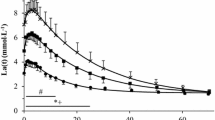Summary
The involvement of the lactacid and alactacid mechanisms in oxygen debt was examined in 2 dogs prior to and after a 6-week training program by using tryptophan and quinolinic acid to block the removal of lactate by the liver. The results show that the lactacid mechanism is involved at work loads resulting in sufficient elevation of blood lactate during the recovery period. It was further shown that training produced a significant decrease in both oxygen debt and blood lactate. Mechanisms responsible for the findings are discussed.
Similar content being viewed by others
Bibliography
Arcos, J. C., Sohal, R. S., Sun, S., Argus, M. F., Buroh, G. E.: Changes in ultrastructure and respiratory control in mitochondria of rat heart hypertrophied by exercise. Exp. molec. Path.8, 49–65 (1968).
Baldwin, K. M.: Oxygen debt and efficiency relationships following treadmill running. Proc. National College Physical Education Assoc. for Men. pg. 84–86, 1966.
Barnard, R. J., Foss, M. L., Tipton, C. M.: Oxygen debt: Involvement of the Cori cycle. Int. Z. angew. Physiol.28, 105–119 (1970).
Bergström, J.: Local changes of ATP and phosphorylcreatine in human muscle tissue in connection with exercise. Circulat. Res.20 and21 (Suppl. I), 91–98 (1967).
Carlsten, A., Hallgren, B., Jagenburg, R., Svanborg, A., Werko, L.: Myocardial metabolism of glucose, lactic acid, amino acids, and fatty acids in healthy human individuals at rest and at different work loads. Scand. J. clin. Lab. Invest.13, 418–428 (1961).
Consolazio, C. F., Johnson, R. E., Pecora, L. J.: Physiological Measurement of Metabolic Function in Man. pg. 8. New York: McGraw-Hill 1963.
Crescitelli, F., Taylor, C.: The lactic response and its relationship to physical fitness. Amer. J. Physiol.141, 630–640 (1944).
Dill, D. B., Talbott, J. H., Edwards, M. T.: The response of several individuals to a fixed task. J. Physiol. (Lond.)69, 267–305 (1930).
Eggleton, M. G., Evans, C. L.: The lactic acid content of the blood after muscular contraction under experimental conditions. J. Physiol. (Lond.)70, 269–293 (1930).
Foss, M. L., Barnard, R. J.: A vest to protect exposed chronic implants in dogs. Lab. Animal Care19, 113–114 (1969).
Freyschuss, U., Strandell, T.: Limb circulation during arm and leg exercise in supine position. J. appl. Physiol.23, 163–170 (1967).
Glick, J. L.: Effects of exercise on oxidative activities in rat liver mitochondria. Amer. J. Physiol.210, 1215–1221 (1966).
—, Brunk, J. B.: The effect of exercise on the rate of oxygen uptake in rat liver mitochondria. Biochim. biophys. Acta (Amst.)82, 165–167 (1964).
Gollnick, P. D., King, W.: The immediate and chronic effect of exercise on the number and structure of skeletal muscle mitochondria. Abstract from International Symposium on Exercise Biochemistry. Brussels, Belgium, number61, pg. 26, 1968.
—, Struck, P. J., Bogyo, T. P.: Lactic dehydrogenase activities of rat heart and skeletal muscle after exercise and training. J. appl. Physiol.22, 623–627 (1967).
Gould, M. K., Rawlinson, W. A.: Biochemical adeptation as a response to exercise I. Effect of swimming on the levels of lactic dehydrogenase, malic dehydrogenase, and phosphorylase in muscles of 8, 11 and 15 week old rats. Biochem. J.73, 41–44 (1959).
Harris, P., Bateman, M., Gloster, J.: The regional metabolism of lactate and pyruvate during exercise in patients with rheumatic heart disease. Clin. Sci.23, 545–560 (1962).
Henry, F. M.: Aerobic oxygen consumption and alactic debt in muscular work. J. appl. Physiol.3, 427–438 (1951).
—, Berg, W. H.: Physiological and performance changes in athletic conditioning. J. appl. Physiol.3, 103–111 (1950).
Holloszy, J. O.: Biochemical adaptations in muscle. Effects of exercise on mitochondrial oxygen uptake and respiratory enzyme activity in skeletal muscle. J. biol. Chem.242, 2278–2282 (1967).
Huckabee, W. E.: Relationship of pyruvate and lactate during anaerobic metabolism. II. Exercise and formation of O2 debt. J. clin. Invest.37, 255–263 (1958).
Kayne, H. L., Alpert, N. R.: Oxygen consumption following exercise in the anesthetized dog. Amer. J. Physiol.206, 51–56 (1964).
Keul, J., Doll, E., Steim, H., Fleer, U., Reindell, H.: Über den Stoffwechsel des menschlichen Herzens. III. Der oxydative Stoffwechsel des menschlichen Herzens unter verschiedenen Arbeitsbedingungen. Pflügers Arch. ges. Physiol.282, 43–53 (1965).
Levy, M. N.: Uptake of lactate and pyruvate by intact kidney of the dog. Amer. J. Physiol.202, 302–308 (1962).
Marbach, E. P., Weil, M. H.: Rapid enzymatic measurement of blood lactate and pyruvate. Clin. Chem.13, 314–325 (1967).
Margaria, R., Edwards, H. T., Dill, D. B.: The possible mechanisms of contracting and paying the oxygen debt and the role of lactic acid in muscular contraction. Amer. J. Physiol.106, 689–715 (1933).
—: The biochemistry of muscular contraction and recovery. J. Sport Med. (Torino)3, 145 (1963).
Robinson, S., Harmon, P. M.: The lactic acid mechanism and certain properties of blood in relation to training. Amer. J. Physiol.132, 757–769 (1941).
Rowell, L. B., Brengelmann, G. L., Blackmon, J. R., Twiss, R. D., Kusumi, F.: Splanchnic blood flow and metabolism in heat stressed man. J. appl. Physiol.24, 475–484 (1968).
—, Kraning II, K. K., Evans, T. O., Kennedy, J. W., Blackmon, J. R., Kusumi, K.: Splanchnic removal of lactate and pyruvate during prolonged exercise in man. J. appl. Physiol.21, 1773–1783 (1966).
Wasserman, K., Burton, G. G., van Kessell, A. L.: Excess lactate concept and oxygen debt concept of exercise. J. appl. Physiol.20, 1299–1306 (1965).
Author information
Authors and Affiliations
Rights and permissions
About this article
Cite this article
Barnard, R.J., Baldwin, K.M. The effect of training and various work loads on the lactacid-alactacid oxygen debt response of exercising dogs. Int. Z. Angew. Physiol. Einschl. Arbeitsphysiol. 28, 120–130 (1970). https://doi.org/10.1007/BF00698051
Received:
Issue Date:
DOI: https://doi.org/10.1007/BF00698051




